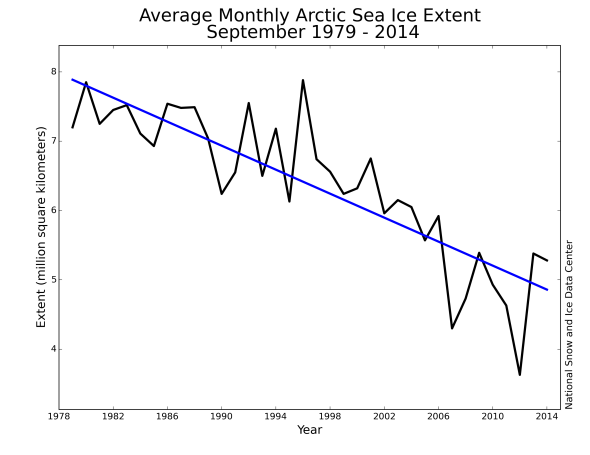A warning: The video you’re about to watch is heartbreaking. In just a few seconds, you’ll see 27 years of Arctic sea ice melt like a handful of snowflakes next to a space heater.
The animation is beautiful, until you realize the implications. Sea ice has become the canary in the coal mine of global climate change.
This animation was produced by painstakingly tracking individual bergs of sea ice for years by satellite and ocean buoys. According to climate.gov, as the animation begins in the 1980s, 26 percent of the Arctic ice pack was four years old or older. By last year, that number had dropped to 10 percent. The oldest ice, once common throughout the Arctic, is now banished to a narrow region near northern Canada.
The Arctic has been warming twice as fast as the rest of the planet in recent years, due in part to the loss of the bright white reflecting surface of sea ice. Darker water is able to retain more heat, leading to a self-reinforcing cycle of melting. A recent study showed that as more of the Arctic reverts to open water, winds are increasing and waves are growing larger—which are further enhancing ice loss. Another study showed that changes in the Arctic may be altering the weather, too.
Here’s what’s happening: For the last 15 years or so, increasingly warm water has been making its way northward, through the narrow gap between Alaska and Russia. Once inside the Arctic, the warm water turns into an ice-eating machine. The summer surge of warmth gnaws away at the edges of the ever-shrinking gyre of floating ice, a relic of the Arctic’s frozen past. New ice can no longer replace the ice that is naturally lost through the Fram Strait, east of Greenland. The result has been a sharp decline in old ice in recent years, with much less resilient younger ice taking its place.
According to the National Snow and Ice Data Center, the 10 lowest Arctic sea ice seasons have all occurred in the last 10 years.
Last year’s melt season was more of the same—resulting in the sixth-lowest extent on record, with open water as far north as 300 miles from the North Pole. That was a new record for the satellite era, which began in 1979.

Image: National Snow and Ice Data Center
Profound changes to the Arctic may be inevitable, but that doesn’t mean climate change is a lost cause. The most recent report from the Intergovernmental Panel on Climate Change said there’s still two precious decades left before the world is locked in to “dangerous” levels of global warming. That ought to be all the motivation we need.